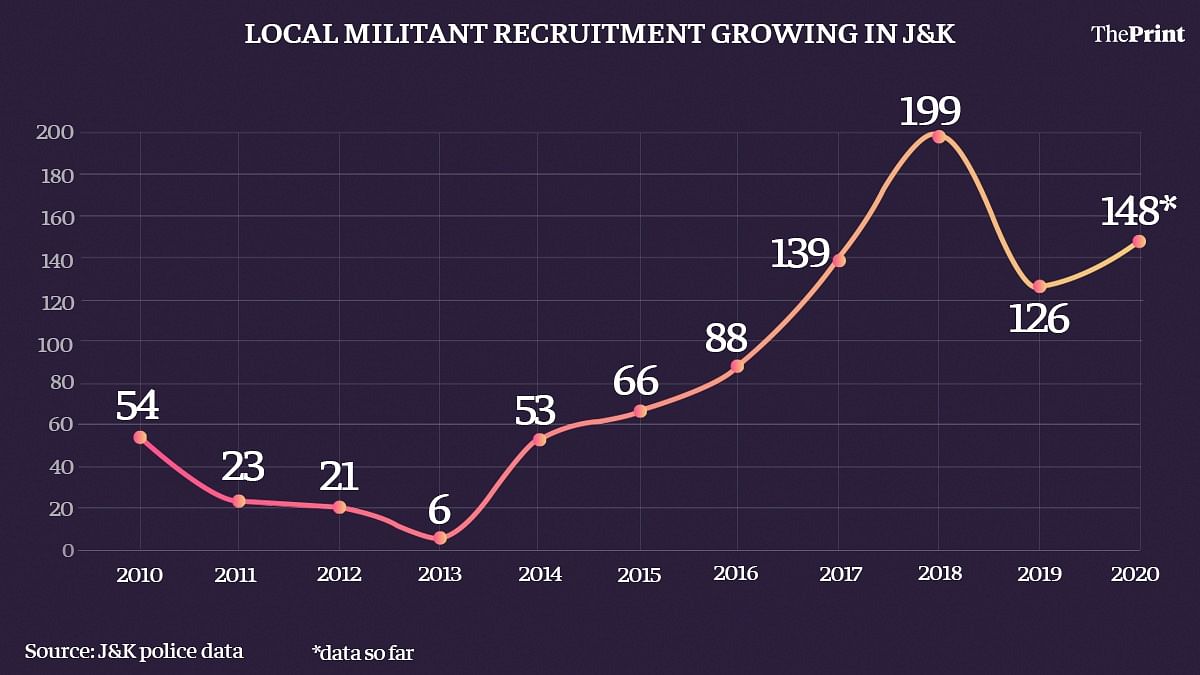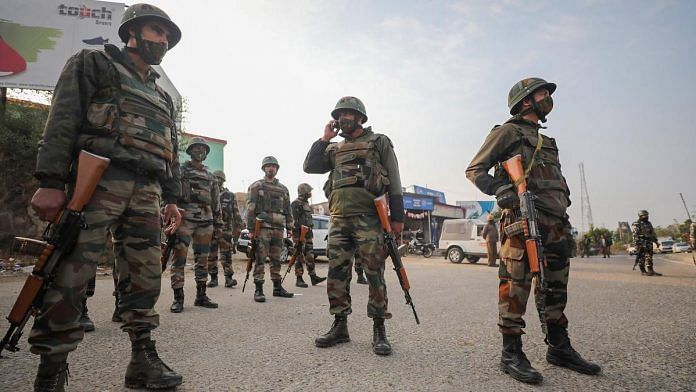Srinagar: On 26 November, two militants casually walked by two personnel of a quick reaction team of the Army at the Aban Shah Chowk in the outskirts of Srinagar. In a fraction of a second, one of the militants pulled out an AK-47 and took a u-turn. Moments later, both the Army personnel came under indiscriminate firing while the local residents present in the area fled.
In a video of the attack released by a militant group on social media, one of the attackers is seen using his right hand to fire the weapon while recording his act with a camcorder in his other.
After the firing spree, the two men — appearing to be in their 20s — walked away and hijacked a Maruti 800 along with the driver. The militants let the driver go after reaching a safe distance and sped away with the car, leaving the authorities scrambling to weave the sequence of events.
While the events and identities of those involved in the attack, which left the two soldiers dead, were established, the location, planning and precision in execution including taping and releasing the footage, show the changing landscape of militancy in Jammu and Kashmir.
Security officials say insurgency in the erstwhile state is taking an uglier turn now, with a rise in local recruitment in militant ranks and a return of the ‘faceless’ insurgency, which existed before the emergence of Burhan Wani and the likes who were visible on social media and used it to broadcast their propaganda.
Also read: 5 arrested in Delhi after encounter with police, officials suspect terror links
Local recruitment — a disturbing trend
According to police data accessed by ThePrint, 2020 saw the second-highest recruitment in the last decade even as over 190 militants were killed by security forces in the year.
Data showed that 148 local residents joined militant ranks this year. However, the number could increase if authorities are able to ascertain the status of over two dozen missing youths across Kashmir, according to sources.

In 2019, the local recruitment in the militant ranks stood at 126. The year 2018 saw the highest militant recruitment in the decade — at 199 — after recruitment of 139 militants in 2017, data showed.
In 2010, 54 Kashmiri youths had joined militant ranks, followed by a steep decline in 2011-2013 when the figures stood at 23, 21 and 6, respectively.
“With the growing popularity of Hizbul Mujahideen’s Burhan Wani, we saw the numbers increase,” said a senior police officer, who didn’t wish to be identified.
In 2014, 53 Kashmiri youth joined militancy while 66 and 88 youths, respectively, became insurgents over the following two years.
A second senior officer also pointed out that the three months of August, September and October this year saw the highest recruitment of militants since 2017 — at 57. During the same period in 2017, 2018 and 2019, 32, 42 and 20 youth joined the militant ranks, respectively.
Radha Kumar, former director-general of Delhi Policy Group, who was appointed as interlocutor after the 2010 Kashmir agitation, said she was not surprised to see the spike in militant recruitment. In the absence of political dialogue, the numbers could increase further, she said.
“After allegations of doctored (rigged) elections in 1986-87, it took two-three years before militancy erupted. After abrogation of J&K special status (on 5 August 2019), I had pointed out that resentment in Kashmir will increase and we could see a renewal in insurgency,” she said.
“The fact that there is no political dialogue (on Kashmir), not even assembly elections, will only further the crisis. All that has happened is election for local administration while the major issues are not being addressed,” she said.
Also read: J&K govt wants court to modify Roshni Act order, says can’t make common people suffer
‘Faceless’ insurgency
While the recruitment numbers paint a grim image for the security establishment, “faceless insurgency” is causing even more concern.
“Burhan Wani and his group changed one thing — which was ending the veil of anonymity attached to Kashmir militancy by posing with their Kalashnikovs and sharing images, glamourising insurgency, on social media,” said a third senior police officer, who is posted in Srinagar.
Speaking on condition of anonymity, he added: “Now we are at a stage where we have eliminated almost all of the militants of the Burhan Wani times. There are no popular faces which could amplify militant recruitment. That is where one has to see the recent incident at Aban Shah Chowk. This was the militant attack to be recorded and shared and it serves as a tool of recruitment.”
The officer added that tactics such as these as well as possible high-profile assassinations and attacks could aid the next phase of Kashmir insurgency, which will be led by “faceless commanders”.
“One has to look at the history of militancy which saw propagation of HAJY — Hamid Sheikh, Ashfaq Majeed, Javaid Mir and Yasin Malik — group… Once the first phase of militancy was neturalised, you see an emergence of faceless Pakistani militants such as Gazi Baba, who was involved in the Parliament attack, Abdullah Unni, who revived insurgency in north Kashmir, Abu Qasim, and Abu Dujana, who revived it in southern parts of the Valley,” said the third officer.
“It was a result of their activities that sustained an insurgency with faces — Burhan, Reyaz Naikoo, Zakir Musa and Sameer Tiger.”
Now, with all of them dead, there is a shift again towards faceless militancy, the officer said, adding that a major strategy for such insurgents is to increase on-ground activity.
According to the officer, these militants are better trained and more armed than local recruits.
“Not only have the Jaish and Lashkar leadership maintained low profile in Kashmir, Hizbul Mujahideen decreasing its activities, emergency of new outfits like The Resistance Front and People’s Anti-Fascist Front (PAFF), all point to this phenomenon,” he said.
Also read: Why India wants UN to stop being ‘selective’ with Abrahamic religions, not take sides
Increasing footprint
Multiple security officials told ThePrint that it is Pakistani militant commanders who are slowly taking over.
“Despite over 190 militants killed this year, about 20 are foreigners. This is important because over 100 foreign militants are active. The use of technology among militants has sharply fallen although they do use some messaging applications,” said a fourth senior police officer.
“They have also been able to establish new overground worker networks after we managed to arrest hundreds of militant associates. But most importantly, there is a renewed focus on central Kashmir,” said the officer, who didn’t wish to be named.
While south Kashmir remains deeply affected by insurgency, the officer said, the militancy in north had been dormant for over five years.
“Now, not only we are seeing increased activity in the north but also in central Kashmir, particularly, Srinagar,” the officer said. This year alone, there have been 20 gunfights in Srinagar and several attacks — the latest in the Hawal area on 6 December.
Hizbul Mujahideen’s militant commander Saifullah too was killed in an encounter on the outskirts of the city, making it one of the most high-profile gunfights in the summer capital of J&K. Prior to that, another Hizbul commander, Junaid Sehrai, son of senior Hurriyat leader Ashraf Sehrai, was killed in an encounter in Srinagar earlier this year.
However, Srinagar Senior Superintendent of Police Haseeb Mughal said militants’ attempts to create unrest in Srinagar are not new.
“There have been 20 encounters this year but all of them have been police initiated action. Militants always try to increase their activity in Srinagar but we have managed to halt them each time,” said Mughal.
Also read: How Gupkar alliance cracks have surfaced in small Baramulla hamlet in J&K DDC polls







These boys should value their lives and avoid violent tendencies.